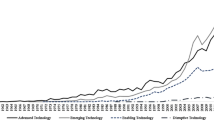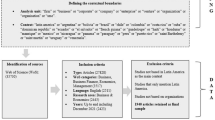Abstract
The knowledge quantification of literature data realizes the analysis of embedded theoretical knowledge from micro to macro, from part to whole, and from special to general. This paper selects the embeddedness related literature included in the core database of web of science from 1985 to 2020 as the sample data, adopts the literature measurement method, analyzes the hot topics and research frontiers of embeddedness theory from the perspective of knowledge evolution, and excavates the evolutionary logic of embeddedness theory research. The research shows that the development and evolution of embeddedness field research is clear from the bilateral connection between economic system and social system to multilateral connection and then to complexity; The hot topics in this field focus on the improvement of theory itself and practical application, but show the phenomenon of interpretation generalization. In the future, it is necessary to carry out research from the aspects of grand theory, middle-level theory, empirical research and the relationship between the three in order to modify and improve the embedded theoretical system.







Similar content being viewed by others
References
Adler P, Kwon S (2002) Social Capital: Prospects for a New Concept. Acad Manage Rev 27(1):17–40
Asakawa K, Park YJ, Song J et al (2018) Internal embeddedness, geographic distance, and global knowledge sourcing by overseas subsidiaries.Journal of International Business Studies
Bresciani S, Ferraris A (2016) Innovation-receiving subsidiaries and dual embeddedness: impact on business performance. Baltic J Manage 11(1):108–130
Cenamor J, Parida V, Oghazi P et al (2017) Addressing dual embeddedness: The roles of absorptive capacity and appropriability mechanisms in subsidiary performance. Ind Mark Manage 78(APR):239–249
Ciabuschi F, Holm U, Martín Martín O (2014) Dual embeddedness, influence and performance of innovating subsidiaries in the multinational corporation. Int Bus Rev 23(5):897–909
Coleman J (1988) Social Capital in the Creation of Human Capital. Am J Sociol 94:95–120
Das TK, Teng BS (2001) Trust, Control, and Risk in Strategic Alliances: An Integrated Framework. Organ Stud 22(2):251–283
Dogbe CSK, Tian H, Pomegbe WWK et al (2020) Effect of network embeddedness on innovation performance of small and medium-sized enterprises. J Strategy Manage 13(2):181–197
Ekman P, Thilenius P, Thompson S et al (2020a) Digital Transformation of Global Business Processes: The Role of Dual Embeddedness. Social Sci Electron Publishing 26(2):570–592
Ekman P, Thilenius P, Thompson S et al (2020b) Digital Transformation of Global Business Processes: The Role of Dual Embeddedness. Social Sci Electron Publishing 26(2):570–592
Fligstein N (1996) Markets and politics: A Political-Cultural Approach to Market Institutions. Am Sociol Rev 61(4):656–673
Fu P (2009) Embeddedness: two orientations and their differences. Sociol Res 24(05):141–164
Halinen A, Tornroos J (1998) The role of embeddedness in the evolution of business networks. Scand J Manag 14(3):0–205
Huang Z, Wang Y (2007) A review of the theoretical research on social embeddedness of economic behavior. Foreign Econ Manage 12:1–8
Hussain T, Deery S (2018) Why do self-initiated expatriates quit their jobs: The role of job embeddedness and shocks in explaining turnover intentions. Int Bus Rev 27(1):281–288
Gebreeyesus M, Mohnen P (2013) Innovation Performance and Embeddedness in Networks: Evidence from the Ethiopian Footwear Cluster. World Dev 41(3):302–316
George G, Dahlander L, Graffin SD et al (2016) Reputation and Status: Expanding the Role of Social Evaluations in Management Research. Acad Manag J 59(1):1–13
Granovetter M (1985) Economic Action and Social Action: The Problem of Embeddedness. Am J Sociol 91(3):481–510
Granovetter M, Swedberg R (1992) The Sociology of Economic Life. Boulder; Westview
Gobiowski T, Lewandowska MS, Magorzata R (2019) Subsidiaries’ dual embeddedness and innovation-related competitive advantage. Gospodarka Narodowa The Polish Journal of Economics 3:5–30
Golgeci I, Ferraris A, Arslan A et al (2019) European MNE subsidiaries’ embeddedness and innovation performance: Moderating role of external search depth and breadth. J Bus Res 102:97–108
Greene J, Mero N, Werner S (2018) The negative effects of job embeddedness on performance. J Managerial Psychol 33(1):58–73
Greta K, Mark G, Fred B et al (2004) Polanyi Symposium: a conversation on embeddedness. Social Science Electronic Publishing, 1:109–135
Huang J, Li M, Mao L et al (2017) The impact of network embeddedness on radical innovation performance - Intermediators of innovation legitimacy and resource acquisition. Int J Technol Policy Manage 17(3):220–239
Hosmer LT (1995) TRUST: THE CONNECTING LINK BETWEEN ORGANIZATIONAL THEORY AND PHILOSOPHICAL ETHICS. Acad Manage Rev 20(2):379–403
Krippner GR (2001) The elusive market: Embeddedness and the paradigm of economic sociology. Theory & Society 30(6):775–810
Lan J, Miao WB (2009) A review of embeddedness theory. Tech Econ 28(01):104–108
Lee TW, Mitchell TR, Sablynski CJ et al (2004) The Effects of Job Embeddedness on Organizational Citizenship, Job Performance, Volitional Absences, and Voluntary Turnover. Acad Manag J 47(5):711–722
Li J, Liu Y, Cao J (2017) Effects of overseas network embeddedness and relationship learning on internationalization performance. J Interdiplinary Math 20(6–7):1581–1586
Li PH (2004) The social logic of the end of the village -- the story of Yangcheng Village. Jiangsu Social Sciences 1:1–10
Li W, Veliyath R, Tan J (2013) Network Characteristics and Firm Performance: An Examination of the Relationships in the Context of a Cluster. J Small Bus Manage 51(1):1–22
Lin N (2002) Constructing network theory of social capital. Sociol abroad 000(002):18–37
Liu LP (2006) Social capital of enterprises: concept reflection and measurement approach. Sociol Res 02:204–216
Liu SD (1999) Embeddedness and relational contract. Sociol Res 4:77–90
Lyu Y, He B, Zhu Y et al (2019) Network embeddedness and inbound open innovation practice: The moderating role of technology cluster. Technol Forecast Soc Chang 144(7):12–24
Mitchell TR, Holtom BC, Lee TW et al (2001a) Why People Stay: Using Job Embeddedness to Predict Voluntary Turnover. Acad Manag J 44(6):1102–1121
Mitchell TR, Lee et al (2001b) The unfolding model of voluntary turnover and job embeddedness: foundations for a comprehensive theory of attachment. Res Organizational Behav 23:189–246
Mcevily B, Zaheer A (1999) Bridging ties: a source of firm heterogeneity in competitive capabilities. Strateg Manag J 20(12):1133–1156
Milena RM (2017) Interorganizational Network Embeddedness and Performance of Companies Active on Foreign Markets. J Manage Bus Adm Cent Europe 25(4):144–157
Nielsen BB (2005) The role of knowledge embeddedness in the creation of synergies in strategic alliances. J Bus Res 58(9):1194–1204
Packard G, Aribarg A, Eliashberg J et al (2016) The role of network embeddedness in film success. Int J Res Mark 33(2):328–342
Polanyi K (1994) The great transformation: the political and economic origins of our time. Press by arrangement with Rinehart & Company
Pomegbe WWK, Li W, Dogbe CS, K et al (2020) Enhancing the Innovation Performance of Small and Medium-Sized Enterprises Through Network Embeddedness. J Competitiveness 12(3):156–171
Portes A (1998) Social Capital: Its Origins and Applications in Modern Sociology. Ann Rev Sociol 24:1–24
Portes A et al (1993) Embeddedness and Immigration: Notes on the Social Determinants of Economic Action. Am J Sociol 98(6):1320–1350
Pu M, Soh PH (2018) The role of dual embeddedness and organizational learning in subsidiary development. Asia Pac J Manage 35(2):1–25
Tian HR, Jia R, Liu YL (2017) Literature review on the relationship between network embeddedness and firm performance -- Based on Meta-analysis. Bus Res 5:129–136
Uzzi B (1996) The Sources and Consequences of Embeddedness for the Economic Performance of Organizations: The Network Effect. Am Sociol Rev 61(4):674–698
Uzzi B (1997) Social Structure and Competition in Interfirm Networks: The Paradox of Embeddedness. Adm Sci Q 42(1):35–67
Uzzi B, EMBEDDEDNESS IN THE MAKING OF FINANCIAL CAPITAL: HOW SOCIAL RELATIONS AND NETWORKS BENEFIT FIRMS SEEKING FINANCING (1999) Am Sociol Rev 64:481–505
Rowley T, Behrens D, Krackhardt D (2000) Redundant governance structures: an analysis of structural and relational embeddedness in the steel and semiconductor industries. Strateg Manag J 21(3):369–386
Smitha R, Rohini, et al (2017) Exploring the effect of workplace spirituality on job embeddedness among higher secondary school teachers in Ernakulam district.Cogent Business & Management, 4(1)
Ulf Andersson M, Forsgren, Ulf Holm (2002) The strategic impact of external networks: subsidiary performance and competence development in the multinational corporation. Strateg Manag J 23(11):979–996
Wang HJ (2000) China studies of new economic sociology. JOURNAL OF NANJING UNIVERSITY (PHILOSOPHY, humanities and Social Sciences), 2:141–152
Wang N, Chen ZJ, Li DS (2015) Research on MNC Subsidiary Evolution under Embeddedness Perspective. Shandong Social Sciences 5:133–138
White HC (1987) Where do markets come from? Am J Sociol 87(3):517–547
Xie X, Wang H, Jiao H (2019) Non-R&D innovation and firms’ new product performance: the joint moderating effect of R&D intensity and network embeddedness. R&D Manage 49(5):748–761
Yan Y, Zhang JJ, Guan J (2020) Network Embeddedness and Innovation: Evidence from the Alternative Energy Field. IEEE Trans Eng Manage 67(3):769–782
Yu Jongsik AM, Antonio G, Gabriele L, Aejoo, Han Heesup (2020). Sustainable Relationship Development between Hotel Company and Its Employees: Linking Job Embeddedness, Job Satisfaction, Self-Efficacy, Job Performance, Work Engagement, and Turnover.Sustainability, 12(17)
Zaheer A, Bell GG (2005) Benefiting from network position: firm capabilities, structural holes, and performance. Strateg Manag J 26(9):809–825
Zelizer VA (1988) Beyond the polemics on the market: Establishing a theoretical and empirical agenda. Sociol Forum 3(4):614–634
Zelizer VA, Chong G, Xing-Hua LI et al (2012) The Economic Sociologists with Relational Orientation and the Meaning of the Turning. Politics & Society 40(2):145–174
Zhao hui, Wu ME, Pullman (2015) Cultural embeddedness in supply networks. J Oper Manag 37(1):45–58
Zukin S, DiMaggio P (1990) Structures of capital: the social organization of the economy. Cambridge University Press
Author information
Authors and Affiliations
Corresponding author
Additional information
Publisher’s Note
Springer Nature remains neutral with regard to jurisdictional claims in published maps and institutional affiliations.
Rights and permissions
About this article
Cite this article
Shan, L., Kun, Z. & Jun-ru, S. Retrospection and prospect of embeddedness theory -- knowledge map analysis based on bibliometrics. J. of Data, Inf. and Manag. 4, 57–70 (2022). https://doi.org/10.1007/s42488-022-00067-5
Received:
Accepted:
Published:
Issue Date:
DOI: https://doi.org/10.1007/s42488-022-00067-5




